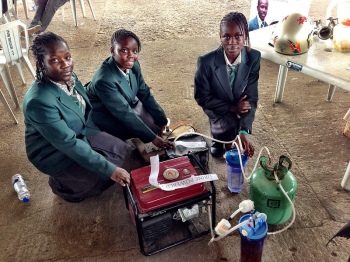Awesome Heros Wield Pee Power

Duro-Aina Adebola, Akindele Abiola, Faleke Oluwatoyin, and Bello Eniola engineered this generator that turns urine into electricity.
A group of four girls ages 14-15 demonstrated their urine-powered generator at the recent Maker Faire Africa in Lagos. The girls’ project also generated a lot of excitement and interest on the web over this last week. Although it won’t be able to compete with the energy output of coal or gasoline, this technique puts forward the possibility that urine could be tapped as one of many (cough) um, clean energy sources. There is probably a stinky pee smell, but clean in this case means it doesn’t give off CO2 emissions or other pollutants.
Let’s take a look at their process—
The Maker Faire Africa blog listed their method as such:
- Urine is put into an electrolytic cell, which separates out the hydrogen.
- The hydrogen goes into a water filter for purification, which then gets pushed into the gas cylinder.
- The gas cylinder pushes hydrogen into a cylinder of liquid borax, which is used to remove the moisture from the hydrogen gas.
- This purified hydrogen gas is pushed into the generator.
Along the whole way there are one-way valves for security, but let’s be honest that this is something of an explosive device…
The generated electricity powers a light bulb which is mostly hidden by the middle girl’s knee in the picture above.
The girls designed their system based on this paper by scientists from the Department of Chemical and Biomolecular Engineering, Ohio University. Here is a more reader-friendly article on the paper that you might want to check out before you decide to explore the scientific paper.
There is also a good deal of scientific debate and skepticism over whether this is a useful or effective electricity generator. The comment thread below that blog post is a good sampling of the discussion.
Good science means hashing out the truth and not taking claims at face value. The only way to know for sure if this process works is to replicate the girls’ setup. With appropriate mentoring and safety precautions, it would be great to see other kids working to recreate this idea. If it turns out that this works…awesome! Then young scientists can work to make improvements to the technique.
We look forward to the day we can feature the work of the first group of teens that powers a cell phone from this kind of pee-powered system. Game on.

You must be logged in to post a comment.